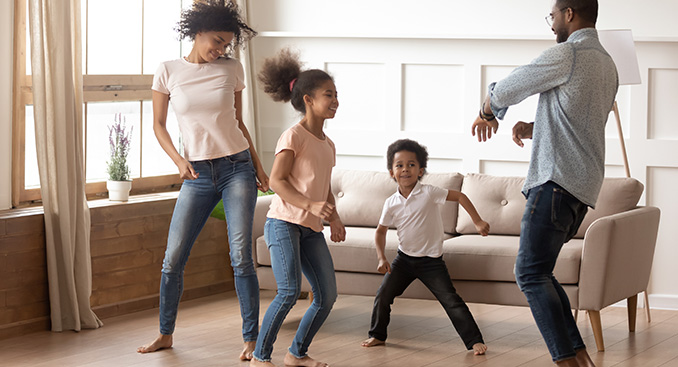10 Ways to Keep Kids Active

Exercise is important for children's physical and mental health. It builds strength for the heart, lungs, muscles and bones; helps control blood sugar and weight; and reduces symptoms of anxiety and depression. According to the 2017-2018 National Survey of Children's Health, only 28 percent of U.S. children met the level of exercise recommended for them: moderate to vigorous physical activity for at least 60 minutes every day. And that was before the COVID-19 crisis sent everyone home and put a temporary end to organized sports, school recess and physical education classes.
Being at home means you're competing with screen time, too. So how to make physical activity fun and appealing to your children? These ideas will help.
1. Create An Indoor Or Outdoor Obstacle Course That Includes Several Exercise Stations.
For example, to move ahead on the course, you have to do a summersault, complete 10 jumping jacks, or stand on one leg for 30 seconds. Use household items like cushions, cardboard boxes, and broomsticks to create the course.
2. Practice Headstands
Most kids enjoy doing headstands and catch on quickly. Headstands exercise core muscles and circulate blood to the brain.
3. Make Foot Races Fun By Changing Things Up
Variations include carrying an egg on a spoon while you run and racing like an animal (hop like a frog or gallop like a horse). If races don't appeal, games like tag and kick-the-can are tried-and-true ways to get kids running.
4. Walk the Dog
If your child is old enough, put him or her in charge of walking the dog.
5. Amp Up Follow-The-Leader
Give each participant a turn at being the leader, and award a prize to the one whose actions are the most energetic.
6. Have A Dance Fest
Alternate between your favorite tunes and those of your kids. When dancing starts to feel dull, incorporate freeze play: Whenever the music stops, everyone has to freeze in place until it starts up again. Take photos of the funniest "freeze" positions.
7. Teach Them Yoga
If you practice yoga, teach your kids the basic positions and run a simple session for them before doing your own practice.
8. Break Out A Jump Rope
Dust off your memories of the rhymes you jumped to as a child or look online for ideas. Kids not interested in rhymes? Hold a competition to see who can jump for the longest time.
9. Create A Carnival
Outside or in a room free of breakables, set up a ball-throwing carnival game. Use cans from the recycling bin, or the bin itself for younger children, as the targets. Set them up on a bench, table or low wall. Award small treats or prizes for hitting the targets.
10. Explore the Outdoors By Hiking
Being outside reduces anxiety and stress, and hiking gets the heart rate up. It also gives you dedicated talk time with your kids-away from televisions and cell phones. If they need an extra incentive, visit the trail ahead of time to set up a scavenger hunt. While hiking, if you see others on the trail, just step off until they pass as needed to maintain 6 feet of separation.
How Much Exercise?
The U.S. Department of Health and Human Services recommends that school-aged children and adolescents (ages 6 to 17) participate in a variety of physical activities they enjoy that are appropriate for their age. They should be physically active for 60 minutes or more each day, including these elements:
- Aerobic activity: either moderate- or vigorous intensity aerobic physical activity (this should make up most of the 60 or more minutes a day).
- Muscle strengthening: activities that involve moving muscles against resistance, such as using free weights, elastic bands, or workout machines, or walking/running up stairs or hills (at least three days a week).
- Bone strengthening: activities that produce an impact on the bones, such as hopping, skipping, jumping rope, running, weight lifting or playing sports like volleyball, tennis and basketball (at least three days a week).